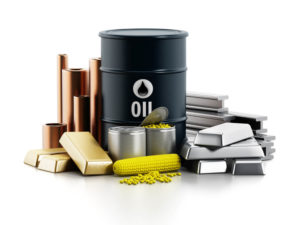
We’re entering into an era of tight supplies following the pandemic. Tight supplies typically mean higher prices, but the slump in demand has helped offset the short supply. At some point, that may not be the case. With the potential for less production and increasing demand, a commodity investment may outperform the equity side as sluggish revenue growth offsets the higher margins from production. The following 10 ETFs are an introduction for investors that want commodity exposure but may not be comfortable trading future
Commodity ETF #1: United States 12 Month Oil Fund LP (NYSEARCA: USL)
USL is an ETF that is designed to track the West Texas Intermediate (WTI) light, sweet crude oil. The fund invests in futures contracts over the next 12 months. The intent is to balance out the futures term structure and the costs of rolling from active contract to active contract.
Commodity ETF #2: United States 12 Month Natural Gas Fund (NYSEARCA: UNL)
UNL is an ETF that is designed to track the movements of the natural gas futures market. The fund weights its investments in futures contracts over the next 12 months. The intent is to balance out the futures term structure and the costs of rolling from active contract to active contract.
Commodity ETF #3: SPDR® Gold Shares (NYSEARCA: GLD)
GLD is an ETF that is designed to reflect the price movements of gold bullion. The fund is backed by physical gold and was the first U.S. listed ETF backed by a physical asset. Because the fund invests in physical gold, it’s not affected by the same potential rollover costs that futures-based products exhibit.
Commodity ETF #4: iShares Silver Trust (NYSEARCA: SLV)
SLV is an ETF that is designed to track the price of silver bullion. Similar to GLD, the fund invests in silver bullion held by a custodian of the silver trust. Shares can be redeemed for physical silver in 50,000 share blocks.
Commodity ETF #5: Teucrium Corn Fund (NYSEARCA: CORN)
CORN provides investors a convenient way for investors to get access to the corn futures market. Corn’s history of tracking the equity market is a reflection of demand increasing with economic growth. If you’re building a commodities portfolio, this fund provides direct ability to track corn prices.
Commodity ETF #6: Teucrium Soybean Fund (NYSEARCA: SOYB)
SOYB provides investors a convenient way for investors to get access to the soybean futures market. Soybeans are one of the most important commodities in the world as the demand has exploded exponentially alongside population growth. If you’re building a commodities portfolio, this fund provides direct ability to track soybean prices.
Commodity ETF #7: Invesco DB Commodity Index Tracking Fund (NYSEARCA: DBC)
While there are plenty of opportunities to invest in each individual commodity using ETFs, DBC seeks to track the performance of 14 of the most actively traded and important physical commodities in the world. Some of the commodities included are crude oil, heating oil, RBOB gasoline, natural gas, gold, silver, aluminum, zinc, copper, wheat, sugar and other commodities.
Commodity ETF #8: Invesco DB Agriculture Fund (NYSEARCA: DBA)
DBA is a diversified agricultural commodities fund. The fund trades exchange-traded futures contracts on corn, soybeans, wheat, sugar, cocoa, and other commodities. The intent of investing in a fund like this is to provide a degree of diversification in the agricultural commodities space that can be achieved by investing in individual agricultural commodity ETFs.
Commodity ETF #9: Invesco DB Base Metals Fund (NYSEARCA: DBB)
DBB is a diversified base metals fund that provides a cost-effective way to invest in commodity futures. The futures investments traded in the fund is on base metals like aluminum, zinc, and copper.
Commodity ETF #10: iShares S&P GSCI Commodity-Indexed Trust (NYSEARCA: GSG)
GSG is similar to DBC in that it invests in a basket of commodities like energy, industrial, and precious metals. Approximately half of the fund is invested in energy through oil and natural gas contracts.
